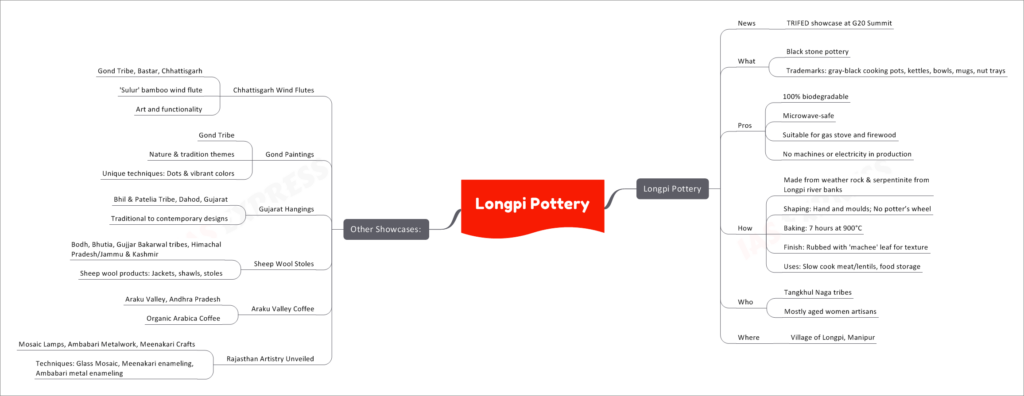Longpi Pottery

- TRIFED Showcase at G20 Summit
This topic of “Longpi Pottery” is important from the perspective of the UPSC IAS Examination, which falls under General Studies Portion.
What is Longpi Pottery?
Longpi Pottery, also known as black stone pottery, is a traditional art form that hails from the Tangkhul Naga tribes of the Longpi village in Manipur, India. It is characterized by its trademark gray-black cooking pots, kettles, bowls, mugs, and nut trays.
Pros of Longpi Pottery
Longpi Pottery boasts several remarkable features that set it apart:
- 100% Biodegradable: Longpi pottery is eco-friendly and biodegradable, making it an environmentally sustainable choice.
- Microwave-Safe: These pottery items are microwave-safe, adding convenience to modern kitchens.
- Suitable for Gas Stove and Firewood: Longpi pottery can be used on both gas stoves and open fires, making it versatile for various cooking methods.
- Handcrafted without Machines or Electricity: The production of Longpi pottery involves no machines or electricity, preserving traditional craftsmanship.
How is Longpi Pottery Made?
The creation of Longpi pottery is a meticulous process:
- Materials: It is made from weather rock and serpentinite sourced from the Longpi river banks.
- Shaping: Artisans shape the pottery using hand techniques and molds, without the use of a potter’s wheel.
- Baking: The pottery is baked for approximately 7 hours at temperatures reaching 900°C.
- Finish: After baking, the pottery is rubbed with ‘machee’ leaf to give it a distinctive texture.
Uses of Longpi Pottery
Longpi pottery finds applications in various culinary practices:
- Slow Cook Meat/Lentils: These pottery items are ideal for slow-cooking meat and lentils, imparting unique flavors to dishes.
- Food Storage: Longpi pottery is also used for food storage due to its natural properties.
Who are the Artisans?
Longpi pottery is predominantly crafted by aged women artisans from the Tangkhul Naga tribes, who have inherited and passed down this traditional art form through generations.
Where is Longpi Pottery Produced?
Longpi pottery is primarily produced in the village of Longpi, located in the state of Manipur, India.
Other Showcases at TRIFED
In addition to Longpi pottery, TRIFED also showcases various other indigenous art forms and products from across India at the G20 Summit:
- Chhattisgarh Wind Flutes: Presented by the Gond Tribe in Bastar, Chhattisgarh, these ‘Sulur’ bamboo wind flutes blend artistry with functionality.
- Gond Paintings: Crafted by the Gond Tribe, these paintings depict nature and traditional themes using unique techniques such as dots and vibrant colors.
- Gujarat Hangings: Presented by the Bhil and Patelia Tribe in Dahod, Gujarat, these hangings feature traditional to contemporary designs.
- Sheep Wool Stoles: Created by the Bodh, Bhutia, and Gujjar Bakarwal tribes in Himachal Pradesh and Jammu & Kashmir, these products include jackets, shawls, and stoles made from sheep wool.
- Araku Valley Coffee: Hailing from Araku Valley in Andhra Pradesh, this coffee is organically grown Arabica coffee.
- Rajasthan Artistry Unveiled: This showcase features mosaic lamps, Ambabari metalwork, and Meenakari crafts from Rajasthan, highlighting techniques like glass mosaic, Meenakari enameling, and Ambabari metal enameling.

